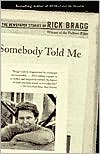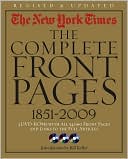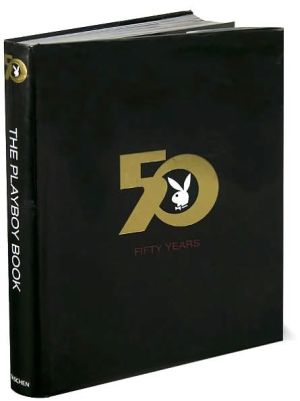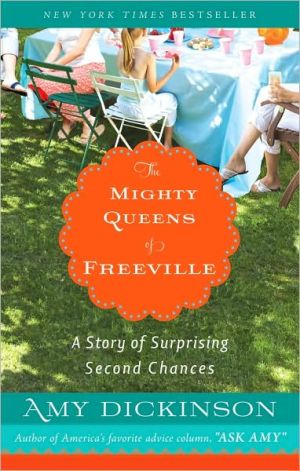Somebody Told Me: The Newspaper Stories of Rick Bragg
With his bestselling All Over but the Shoutin', Rick Bragg gave us memorable stories of his own childhood. In Somebody Told Me, he offers the best of his work as a Pulitzer-Prize winning journalist writing the remarkable stories of others.\ For twenty years, Bragg has focused his efforts on the common man. So while some of these stories are about people whose names we know-such as Susan Smith, the South Carolina mother who drowned her two sons-most are people whose names we've never heard,...
Search in google:
Some 60 of Pulitzer Prize winning reporter Bragg's articles, mostly written for the . The articles cover victims of natural disasters, prison inmates, economic inequality, the elderly, race, Louisiana bayou culture, schools, and other issues of the American scene (including three articles on former Alabama governor George Wallace and seven stories on Susan Smiththe Carolina woman accused of drowning her children after alleging a Black carjacker kidnapped them). Annotation c. Book News, Inc., Portland, OR KLIATT Stories of heroes, death, life and triumph—all seasoned with a "bit of southern humor and perspective"—make this an entertaining and informative read. A national correspondent for the New York Times based in New Orleans, Bragg gives the reader a glimpse of human drama and complex relationships in an historical context of the 20th-century South—a region reflecting the great social, economic, and political changes of modern times. The book is nicely divided into thematic categories—"Secrets," "Silver Hair-Golden Years," and "Colors" are examples—which is a nice readability feature. Another positive aspect is the combination of readability and thematic structure—lending to effective use as an assignment-based tool in a variety of high school curriculum areas (sociology, U.S. history, English, etc.) My only wish for this excellent presentation would be the inclusion of an index. The wealth of information associated with this work would make it a great reference tool for SLMAs across the nation. Category: Collections. KLIATT Codes: SA—Recommended for senior high school students, advanced students, and adults. 2000, Random House, Vintage, 277p., Ages 16 to adult. Reviewer: Tom Adamich; Tech. Serv., Stetson Univ., College of Law, S. Pas
\ \ \ \ \ Chapter One\ \ \ Survivors\ \ \ At first I wanted to call this chapter "Victims," but that cheapened the people I wrote about. I decided on "Survivors" because so many of the people herein were seized by an outside force, terrified or damaged, and let loose to try and live again. I like these people because of their backbone. I do not mind that some of them became haters. Some of them had a right.\ \ \ * * *\ \ \ Tried by Deadly Tornado, An Anchor of Faith Holds\ New York Times, April 3, 1994\ DATELINE: Piedmont, Ala., April 2\ \ \ This is a place where grandmothers hold babies on their laps under the stars and whisper in their ears that the lights in the sky are holes in the floor of heaven. This is a place where the song "Jesus Loves Me" has rocked generations to sleep, and heaven is not a concept, but a destination.\ Yet in this place where many things, even storms, are viewed as God's will, people strong in their faith and their children have died in, of all places, a church.\ "We are trained from birth not to question God," said 23-year-old Robyn Tucker King of Piedmont, where 20 people, including six children, were killed when a tornado tore through the Goshen United Methodist Church on Palm Sunday.\ "But why?" she said. "Why a church? Why those little children? Why? Why? Why?"\ The destruction of this little countrychurch and the deaths, including the pastor's vivacious 4-year-old daughter, have shaken the faith of many people who live in this deeply religious corner of Alabama, about 80 miles northeast of Birmingham.\ It is not that it has turned them against God. But it has hurt them in a place usually safe from hurt, like a bruise on the soul.\ They saw friends and family crushed in what they believed to be the safest place on earth, then carried away on makeshift stretchers of splintered church pews. They saw two other nearby churches destroyed, those congregations somehow spared while funerals for Goshen went on all week and the obituaries filled an entire page in the local paper.\ But more troubling than anything, said the people who lost friends and family in the Goshen church, were the tiny patent-leather children's shoes scattered in the ruin. They were new Easter shoes, bought especially for church.\ "If that don't shake your faith," said Michael Spears, who works at Lively's Food Market in downtown Piedmont, "nothing will."\ The minister of the Goshen church, the Rev. Kelly Clem, her face covered with bruises from the fallen roof, buried her daughter Hannah on Wednesday. Of all people, she understands how hurtful it is to have the walls of the church broken down.\ "This might shake people's faith for a long time," said Mrs. Clem, who led a congregation of 140 on the day of the storm. "I think that is normal. But having your faith shaken is not the same as losing it."\ Ministers here believe that the churches will be more crowded than usual on Easter Sunday. Some will come for blessings, but others expect an answer.\ \ \ Mrs. Clem and her husband, Dale, who is also a minister, do not believe God sent the storm that killed their daughter and 40 other people across the Southeast in a few short hours that day. The Clems make a distinction between God's laws and the laws of nature, something theologians have debated for years: what does God control, and not control?\ The people here know only that they have always trusted in the kindness and mercy of God and that their neighbors died in His house while praising His name. It only strengthens the faith in some people, who believe that those who die inside any church will find the gates of heaven open wide.\ Others are confused. Beyond the sadness and pain is a feeling of something lost, maybe forever.\ "It was church," said Jerri Kernes, delivering flowers to a funeral home where the dead and their families filled every room.\ "It isn't supposed to happen in church."\ \ \ The blooming dogwood trees stand out like lace in the dark pine barrens in the hills around Piedmont. The landscape is pastoral, mountain ridges and rolling hills divided by pastures of fat cows and red-clay fields that will soon be high cotton and sweet corn.\ The people, the children of farmers, mill workers, carpenters and steelworkers, now make tires at the Goodyear plant in Gadsden, spin yarn at the cotton mill and process poultry for Tyson Foods Inc., which is known here as just the chicken plant.\ Yet, Piedmont, population 5,200, depending on who is home, exists in the failed economic promise of the New South. The roof on the empty brickyard has rusted through, and the pretty little train station on the Selma, Rome & Dalton line is just for show. The cotton mill just had a new round of layoffs.\ As economic uncertainty grows, the people go to the altar for hope, said Vera Stewart, Piedmont's 70-year-old Mayor. Piedmont, after all, has two doctors' offices but 20 churches.\ "As long as we have our faith, we are as strong as our faith," Mrs. Stewart said. "Because no matter how dark it is, if I have faith, I have a song in the night."\ But in the long days since last Sunday, when the sky opened, she, too, has felt that belief tremble. What all the troubles of the everyday failed to do, one sudden, violent moment did.\ Tornadoes snapped 200-year-old trees and ruined houses and lives in five states. Goshen was the centerpiece of an agony shared by Spring Garden, Rock Run, Possum Trot, Bennefield's Gap, Knighten's Crossroad and Webster's Chapel. At Mount Gilead Church, about 10 miles from Goshen, the wind pulled tombstones from the earth and smashed them.\ People here are accustomed to the damage that the winds do, but what happened at the Goshen church last Sunday was off the scale of their experience. Rescue workers found neighbors limp and broken on the ground, and strong men sobbed like babies in the arms of other men when the last of the living and dead had been dug from the rubble.\ In a makeshift morgue in the National Guard Armory, one volunteer wiped the faces of the dead children before zipping up the body bags. The bags were too long, and had to be rolled up from the bottom.\ But in the days after, the shock started to wear off, and the pride took hold again. So, when the truckloads of donated food and clothes arrived, some of the needy refused aid because they did not earn it with their own sweat.\ \ \ Sam Goss runs a filling station, and believes in heaven the same way he believes that walking in the Coosa River will get him wet.\ Mr. Goss, 49, stood in a line 50 yards long to pay respects to the dead at the town's largest funeral home. He smoked a cigarette, cried and talked of going to Glory.\ He was a friend of Derek Watson, who died with his wife, Glenda Kay, and their 18-year-old daughter, Jessica. Mr. Goss said Derek, who worked at the Super Valu, had not planned to go to church that day but changed his mind.\ "Maybe that's what people mean when they say God works in mysterious ways," Mr. Goss said. "I know the boy. He could not have lived if his wife and child were gone."\ It is the same reason, he said, that God took both Ruth Peek, 64, and Cicero Peek, 72.\ "It's hard not to question God in this," he said. "But they say there ain't no tears in heaven. We're the ones left to hurt. You see, God took them because he knew they were ready to go. He's just giving all the rest of us a second chance."\ \ \ The first step toward healing might have been in a funeral processional for a child.\ In life, 4-year-old Hannah Clem had been a dancer and painter and singer.\ In death she has become a focus of the question why.\ For three days Kelly and Dale Clem worked for their friends and parishioners and swallowed their own pain, gracious and strong. They did not shake their fist at heaven, but told Vice President Al Gore that a better storm warning system might have saved lives.\ It was wind and not God, they said, that killed their daughter.\ "My God is a God of hope," Mr. Clem said. "It is never his will for anyone to die."\ It is a departure from the Christian mainstream belief that God controls all. But then so is Mrs. Clem herself, a female minister with a growing congregation in a small town in the Deep South.\ On Wednesday, she followed Hannah's tiny white and pink casket up the aisle at the First United Methodist Church in Anniston, 20 miles from Goshen. Members of her congregation and old friends filled the church.\ "People have asked, why did it happen in a church," said the Rev. Bobby Green, in his service. "There is no reason. Our faith is not determined by reason. Our faith is undergirded by belief, when there is no reason."\ In the Bible, Palm Sunday is a day of destruction, not hope, he said. Hope comes later, on Easter Sunday.\ The 400 mourners stood and said the Lord's Prayer. Then, Hannah's coffin was moved slowly back down the aisle to the hearse. The organist played "Jesus Loves Me."\ \ \ * * *\ \ \ On Walls, Memories of the Slain Are Kept\ New York Times, January 28, 1994\ \ \ Somewhere, between one more killing in the inner city and the obscurity of the grave, is a wall in Brooklyn.\ Khem Hubbard recorded her brother's name there last week, in big silver letters. Now Kyle Rasheim Hubbard, 19, shot to death on Jan. 6, 1990, will be remembered in a New York neighborhood where the dead disappear in the crowd.\ The memorial wall at the corner of Crown Street and Bedford Avenue in the Crown Heights section of Brooklyn is like the ones in Bedford-Stuyvesant, the ones in the South Bronx, the ones in Harlem. They hold the names of dead children, innocent bystanders, stone-cold killers, untrue lovers and fallen angels.\ They are remembered with elaborate murals that plead for a stop to the senseless killing, or just a few thin lines scrawled by a friend with a felt-tip pen and a broken heart. They tell us that PAPA RESTS IN PEACE, and that Kiki has found God.\ No one is sure how many walls there are in New York, or how many inner-city victims have taken their place on the lists of the dead that decorate the sides of dry cleaners, clinics and corner stores. People who live beside the walls guess that there are hundreds scattered around the city, embroidered with thousands of names. Around the nation are thousands more, from Atlanta to Los Angeles.\ The dead have been carried off to cemeteries outside the inner city, but people here like to believe their spirit is still in the neighborhood and\ (Continues...)\ Almost Family\ \ \ By Roy Hoffman\ \ The University of Alabama Press\ Copyright © 1983 Roy Hoffman. All rights reserved.\
Introduction,1 SURVIVORS Tried by Deadly Tornado, An Anchor of Faith Holds,4 On Walls, Memories of the Slain Are Kept,8 Still Haunted, Families See Justice in Shape of a Killer's Grave,13 The Valley of Broken Hearts,16 FOUR WALLS TO HOLD ME Where Alabama Inmates Fade into Old Age,23 Inmates Find Brief Escape in Rodeo Ring,28 A Thief Dines Out, Hoping Later to Eat In,33 Man Imprisoned for 30 Years Is Rid of Bars but Not Fears,37 Prisoner's Pittance Is Meant As Reminder of a Great Loss,43 HURTFUL THINGS New York's Bodegas Become Islands under Siege,47 "I Never Seen Nothing Like That,"53 Living in Another World,61 Where a Child on the Stoop Can Strike Fear,67 The Story of Dirty Red,74 SECRETS Town Secret Is Uncovered in Birth Quest,82 Woman, Sold as Infant in '65, Grasps at Clues to Her Roots,87 New Development Stirs Old Case,92 Autism No Handicap, By Defies Swamp,100 SILVER HAIR, GOLDEN YEARS All She Has, $150,000, Is Going to a University,105 Band PlaysOn for Class of '39109 Woman Clings to Her Paradise,116 Little Women Look Back on a Lost World,119 Country Club Meets Enemy: Country Music and Pigs,123 ICONS The King Is Long Dead, but Long Live the King,126 Savoring a Sweet Taste of Southern Summers,130 A Delicacy of the Past Is a Winner at Drive-In,133 A Sugar Bowl Lacking a Certain Sweetness,135 GEORGE CORLEY WALLACE Emotional March Gains a Repentant Wallace,140 A Symbol of Alabama's Past, Indelible to Black and White,143 Wallace Remembered, for Who He Was and Who He Became,147 MONUMENTS In New Orleans, a Day for Visiting the Dead,151 A Coach's Shrine, the Fátima of Alabama Football,154 A Balladeer of Bluegrass Is Now Gone Yet Lives On,156 BOURBON AND BAYOUS French Quarter's Black Tapping Feet,160 In a Louisiana Bayou Town, "Uncle Pal" Is the Law,164 In Louisiana, Card Game Reveals the Cajun Spirit,166 Cajun Christmas Tradition Refuses to Die Down,169 COLORS To Bind Up a Nation's Wound with Celluloid,174 Just a Grave for a Baby, but Anguish for a Town,180 Racism Wins in Small Town in Texas,183 Fort Bragg Area Is Haunted by Ghost and Two New Deaths,189 Unfathomable Crime, Unlikely Figure,193 For Jasper, Just What It Didn't Want,196 BOMBS In Shock, Loathing Denial: "This Doesn't Happen Here,"200 Tender Memories of Day-Care Center Are All That Remain after the Bomb,202 Oklahoma Toll Is No Longer in Deaths, but in Shattered Lives,206 In Oklahoma City, Recovery a House at a Time,212 Altered by Bombing, but Not Bowed,215 SUSAN An Agonizing Search for Two Boys,219 Mother of "Carjacked" Boys Held in Their Deaths,222 Sheriff Says Prayer and a Lie Led Susan Smith to Confess,225 Psychiatrist for Smith's Defense Tells of a Woman Desperate to Be Liked,228 Father Testifies in Penalty Part of Smith Trial,231 Carolina Jury Rejects Executioner Woman Who Drowned Sons,234 A Killers Only Confidant. The Man Who Caught Susan Smith,238 SCHOOLYARDS Arkansas Boys Held as Prosecutors Weigh Options,242 Determined to Find Healing in a Good and Decent Place,246 Past Victims Relive Pain As Tragedy Is Repeated,250 Jonesboro Dazed by Its Darkest Day,254 Murder Trial Opens for First School Shooting Defendant,259 Arkansas Boys Who Killed Five Are Sentenced,261 LIVING AND DYING Living with a Grief That Will Never Die,266 On Florida Bridge, Troopers Are Also Suicide Counselors,270 Jazzy Final Sendoff for Chicken Man,274
\ KLIATTStories of heroes, death, life and triumph—all seasoned with a "bit of southern humor and perspective"—make this an entertaining and informative read. A national correspondent for the New York Times based in New Orleans, Bragg gives the reader a glimpse of human drama and complex relationships in an historical context of the 20th-century South—a region reflecting the great social, economic, and political changes of modern times. The book is nicely divided into thematic categories—"Secrets," "Silver Hair-Golden Years," and "Colors" are examples—which is a nice readability feature. Another positive aspect is the combination of readability and thematic structure—lending to effective use as an assignment-based tool in a variety of high school curriculum areas (sociology, U.S. history, English, etc.) My only wish for this excellent presentation would be the inclusion of an index. The wealth of information associated with this work would make it a great reference tool for SLMAs across the nation. Category: Collections. KLIATT Codes: SA—Recommended for senior high school students, advanced students, and adults. 2000, Random House, Vintage, 277p., Ages 16 to adult. Reviewer: Tom Adamich; Tech. Serv., Stetson Univ., College of Law, S. Pas\ \ \ \ \ Library JournalThis collection displays Bragg's ability to capture time and place in a vivid prose that is consistently eloquent, sincere, and sympathetic. In his introduction, Bragg (All Over but the Shoutin') credits his storytelling family with teaching him how to listen and relate a tale. He acknowledges that "the best stories in the newspaper are those of people in trouble, and those are the ones I care about writing." This anthology of over 60 articles includes Bragg's work with the Birmingham News, the St. Petersburg Times, and the New York Times, where he is currently the Miami bureau chief. The Pulitzer Prize-winning journalist's works on the Oklahoma City bombings, the Susan Smith case, and schoolyard killers, among others, are collected here. Bragg's respect for ordinary people allows him to shape his stories with clarity and compassion. His book reminds the reader that lives go on and stories need to be written down so they won't be forgotten after the headlines fade. Recommended for all public and academic libraries.--Pam Kingsbury, Florence, AL Copyright 2000 Cahners Business Information.\\\ \ \ Ruth Bayard SmithBragg's writing engages us as readers and poignantly conveys the impact of small and large events on everyday life. \ —The New York Times Book Review\ \ \ \ \ Thomas FrenchNo one on this earth writes like Rick Bragg. Search every inch of this planet's surface and you will never find another writer who makes words sing so sweetly, who involves us so completely in the beauty and grace and heartaches of ordinary lives, whose stories soar and churn and cry with such broken, desolate power. Rick has a gift that other writers would sell their souls for, and that readers cannot resist. The stories in Somebody Told Me are so unbelievably good they will burn a hole in your bookshelf. \ — Thomas French, St. Petersburg Times\ \ \ \ \ Kirkus ReviewsA collection of did-you-hear-about-the-person-who articles by a Pulitzer-winning New York Times feature reporter. `I keep thinking,` writes Rick Bragg (All Over But the Shoutin', 1997), `that someday I will not have to write about race, about hatred. I keep thinking that.` There are a lot of such thoughts in this anthology of the features Bragg has published over the last 13 years, primarily as Miami bureau chief for the New York Times. Alabama-raised but now Florida-based, Bragg's journalistic territory ranges as far north as the streets and projects of Brooklyn and as far west as the plains and oilfields of Texas; Southern sense and sensibility pervades his reporting throughout, without compromising its integrity or limiting its appeal. More than half of these 64 features focus in some fashion or other upon the stories and plight of America's least wanted: in Miami we are introduced to the Shantytown homeless (who hope for little more in the way of shelter than dry cardboard); in New Orleans we meet the children who live at the St. Thomas housing project (and are looked upon as survivors if they succeed in turning 13); and in Brooklyn we are given a brief tour of the bodegas (whose owners live in constant hope that their next customer won't bear fatal tender). Here again are the acts once unimaginable and now seemingly commonplace, here again are the names and places that became familiar: Oklahoma City; Susan Smith; Jasper, Texas. A welcome third of the stories have lighter subjects: a sweet-tea brew-off, Cajun Christmas traditions in the Mississippi delta, and Oseola McCarthy (the washwoman who accumulated a small fortune and gave it all to the Universityof Alabama).`There is a lot of sadness in this [book] because the best stories in the newspaper are those of people in trouble,` Bragg warns. Journalists, sociologists, and psychologists will find much in Bragg's observations to consider and reconsider. Most readers will, too.\ \







